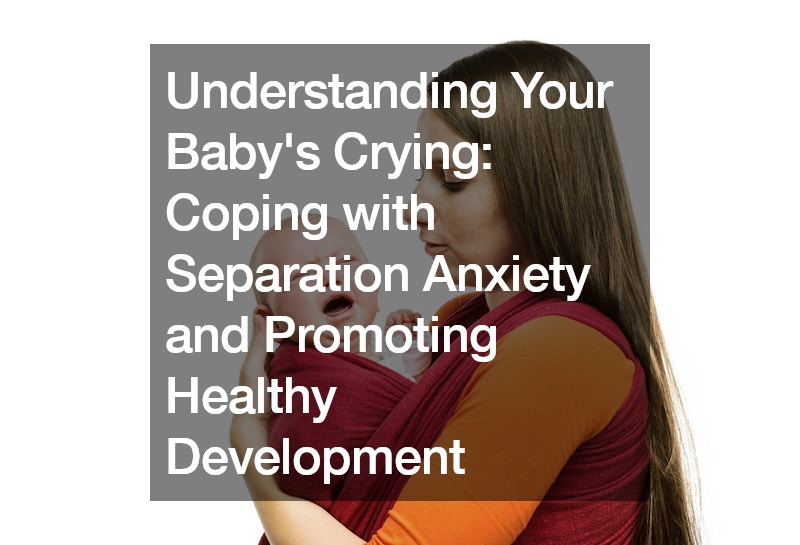As a parent, witnessing your baby’s tears can tug at your heartstrings. However, understanding the reasons behind their cries can provide valuable insights into their development and help you navigate this challenging phase with confidence. One common reason for a baby’s tears is separation anxiety, a natural stage of development that typically occurs between eight to 12 months of age, with a peak around nine months.
Separation anxiety is a normal part of a baby’s emotional growth, signaling their increasing awareness of object permanence. This developmental milestone means that your baby understands that objects, including you, continue to exist even when they cannot see them.
As a result, when you leave the room, your baby may become distressed, seeking your presence and reassurance.
Recognizing separation anxiety as a positive indicator of your baby’s cognitive and emotional development can help alleviate some of your concerns. It signifies a strong attachment between you and your baby, demonstrating their desire to be close to caregivers and familiar faces they trust.
During this phase, it’s essential to implement strategies to support your baby’s emotional well-being while promoting their independence. One approach is to gradually expose your baby to short periods of separation, allowing them to become accustomed to your absence in a safe and controlled environment. For example, you can enlist the help of another caregiver to hold or engage with your baby while you step away for brief intervals.
Effective communication is key when preparing your baby for temporary separations. Inform them verbally before leaving the room, reassuring them that you will return shortly. This clear and consistent communication helps build trust and confidence in your baby, minimizing their anxiety during your absence.
Additionally, providing comfort items, such as a favorite toy or blanket, can offer a source of reassurance for your baby when you are not present. These familiar objects provide a sense of security and familiarity, helping your baby feel more at ease in new or unfamiliar settings, such as a childcare center.
Timing is also crucial when planning separations. Avoid leaving your baby when they are tired or hungry, as these conditions can exacerbate their distress. Instead, choose moments when your baby is well-rested and fed to minimize their vulnerability to stressors.
When saying goodbye to your baby, keep your farewells brief but reassuring. Express your love and intention to return, then depart promptly. Prolonged goodbyes may escalate your baby’s anxiety, making the separation more challenging for both of you.
Consistency is paramount in managing separation anxiety. Follow through on your promises to return, reinforcing your baby’s trust in your presence. Whether it’s picking them up from a childcare center or returning home after running errands, be reliable in your actions to foster a sense of security in your baby.
While separation anxiety is a natural phase of development, some babies may exhibit more pronounced symptoms or struggle to cope with separations. In such cases, seeking guidance from a pediatrician can provide valuable support and tailored advice to address your baby’s specific needs.
Understanding and navigating your baby’s separation anxiety requires patience, empathy, and proactive caregiving. By recognizing the significance of this developmental milestone and implementing supportive strategies, you can help your baby navigate this phase with confidence while promoting their healthy emotional development.
In conclusion, separation anxiety is a normal part of your baby’s growth journey, indicating their cognitive and emotional milestones. By employing effective communication, providing comfort, and maintaining consistency, you can help your baby cope with separations while fostering their independence and emotional well-being. Remember to seek professional guidance if you have concerns about your baby’s emotional development, and approach this phase with patience and understanding.
Here are some additional topics to consider when addressing separation anxiety in babies:
- Understanding the Signs of Separation Anxiety: Recognizing the behavioral cues and physical symptoms that indicate your baby is experiencing separation anxiety can help you respond appropriately and provide comfort.
- Creating a Safe and Secure Environment: Designing a nurturing and predictable environment at home and in childcare settings can help ease your baby’s anxiety and promote feelings of safety and security.
- Building Trust and Attachment: Fostering a strong bond with your baby through responsive caregiving and affectionate interactions can help alleviate separation anxiety and promote healthy attachment.
- Supporting Transitions and Adjustments: Helping your baby navigate transitions, such as starting daycare or welcoming a new caregiver, requires patience and sensitivity to their individual needs and preferences.
- Self-Care for Parents: Managing your own emotions and stress levels is essential for providing consistent and supportive care to your baby during times of separation anxiety.
By addressing these additional topics, you can gain a more comprehensive understanding of separation anxiety in babies and develop effective strategies for promoting your baby’s emotional well-being and healthy development.
.


